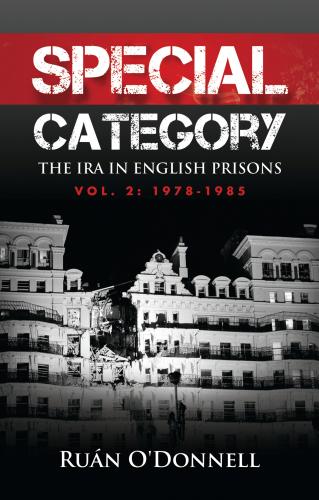263.Irish political prisoners, p. 94. Mick Sheehan, the only other IRA prisoner in Gartree in July 1978, was too physically ill to participate in the roof top demonstration. By escaping punishment he was in a position to smuggle tobacco, matches and newspapers to his comrades in the Punishment Block. See Hayes (ed.) In prison in England, p. 23.
264.Sr. Clarke, ‘Jerry Mealy’, Clarke Papers (COFLA). Mealy had received ‘open’ visits in Gartree. Sr. Clarke, ‘Albany’, Clarke Papers (COFLA).
265.Irish Times and Times, 10 July 1978.
266.Armstrong to Wilson, 27 September 1978, Private Collection (Wilson).
267.McLaughlin, Inside an English jail, p. 45. McLaughlin recalled: ‘I was given a towel to wrap around me but no blanket. My bed was removed from the cell between 6.00 a.m. and 8.00 p.m. The only time that I was allowed out of the cell was at 7.00 a.m. to slop out. During the weeks that I spent on the blanket, I never talked to another prisoner and only very infrequently to the screw. When my wife visited me in October she informed me that there was no support among the other POWs throughout England for a sustained blanket protest. So I decided to come off the protest’. Ibid., pp. 45–6.
268.Wakefield IRA PRO to editor, Irish News, 13 November 1978. See also Irish News, 8 September 1978.
269.Republican News, 5 August 1978.
270.Report of the work of the Prison Department, 1978, p. 26.
271.Report of the work of the Prison Department, 1978, p. 26.
272.Republican News, 26 August 1978.
273.Irish World, 26 August 1978. See also Ibid., 2 and 30 September 1978.
274.IRIS, 1 September 1978, p. 2.
275.Faul and Murray, H Blocks, p. 44. Nine Articles of the Convention were identified as having been transgressed (3, 6, 8, 9, 10, 11, 13, 14 and 18). These included breaches on ‘degrading treatment’, ‘impartial tribunals’, ‘freedom of association’ and utilization of solitary confinement. Ibid.
276.Statement of Archbishop Tomas O Fiaich, 1 August 1978 in Faul and Murray, H Blocks, p. 28.
277.For reaction to O Fiaich’s comments see Hibernia, 3 August 1978, Irish Times, 5 August 1978 and Irish Press, 2 August 1978. In January 1978 O Fiaich, in his first major interview after becoming Primate, stated his opinion that the British ‘should leave’ Ireland. Irish World, 21 January 1978. He regarded Cork IRA leader Tom Barry, an acquaintance, as a man devoted to ‘freedom for the Irish people to be themselves and to be masters of their own country’. O Fiaich cited in Meda Ryan, Tom Barry, IRA Freedom Fighter (Cork, 2005), p. 14.
278.See Irish World, 26 August 1978.
279.Sr. Sarah Clarke to the Editor, Catholic Herald, 1 September 1978.
280.Mason, Paying the price, p. 210.
281.NIO, 1 August 1978, ‘Comment by Northern Ireland Office spokesman on Archbishop O’ Fiaich’s statement’, PRONI, NIO/12/68.
CHAPTER 2
Gartree, Wormwood Scrubs and the Blanket Protest in England
The Gartree Riot of 5–6 October 1978 was a non-political and essentially spontaneous upheaval in which IRA men played a part. As with Hull in 1976, the trigger for what mushroomed into a major protest was a belief amongst the prison population that one of their associates had been maltreated. In this instance, the bone of contention revolved around the alleged involuntary drugging or tranquilization of a black prisoner.1 Complaints on such practices had been smuggled out of Gartree to the prisoner’s organization PROP for two years before the matter sparked a riot.2 Martin Brady noted the general deterioration of conditions, with reductions in association time, during which ‘exercise yards only opened if the sun shone’. He identified the ‘abuse of drugs from the medical side’ as the primary cause of the violence which ensued. In Gartree, Brady claimed, ordinary prisoners received ‘whatever … [they] wanted – Mogadon, any kind of sleeping tablets … Nothing recorded’.3 Ronnie McCartney likened the surreal atmosphere at times to the disturbing chaos and alternating chemically induced conformity depicted in Stanley Kubrick’s feature film One Flew Over The Cuckoo’s Nest.4
Allegations persisted that inappropriate dosages of dangerous drugs were being administered in English prisons in pursuit of an agenda to either conduct experiments in a controlled environment or simply render prisoners more subject to control. Establishing the truth proved extremely difficult in the face of the numerous defence mechanisms devised by the Home Office. The BBC was successfully sued in the High Court in July 1978 for alleging improper practices in Albany on the part of Dr. Brian Cooper and Dr. Andrew Todd.5 Dr. Cooper was a familiar name to IRA prisoners, and despite his public and private disavowals, was widely regarded as the man who force-fed Michael Gaughan to death in June 1974. His professional position had been consolidated in Parkhurst by the October 1969 riot from which he emerged with a modicum of credit. From 1970, he and Mr. Anthony Pearson supervised an experimental unit in Parkhurst’s C Wing for mentally disturbed prisoners. Inmates were given small financial inducements to work and to behave well during leisure periods. Payment was calculated on a sliding scale from zero to ninety pence a week and overall conduct was linked to other forms of amelioration. Cooper and Pearson administered a ‘progression’ path in C Wing ‘from the ground floor living area to a top floor pre-release area’. They were, in consequence, influential figures on the Isle of Wight in 1972 prior to the return of significant numbers of IRA men to the prison.6 The operation of C Wing in this mode ceased abruptly in March 1979 when the destruction of the roofs of two other wings by the IRA inspired the relocation of its inhabitants into the ill-appointed Hospital Wing.7
A BBC documentary entitled South Today alleged in February 1978 that men were being drugged in Albany to render them docile. This tangentially implicated Dr. Cooper and Dr. Todd, who both had overall responsibility for issuing prescriptions on the island. Cooper,
